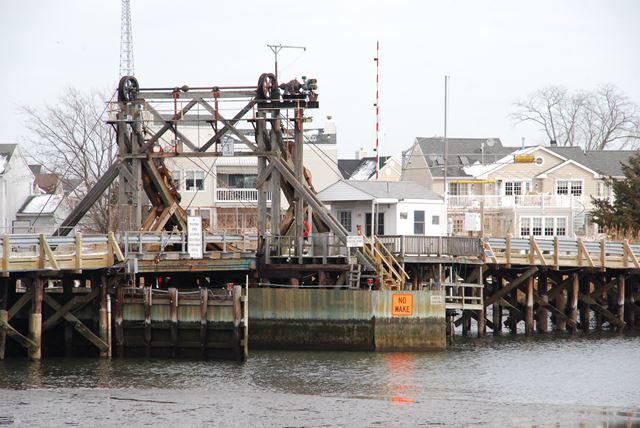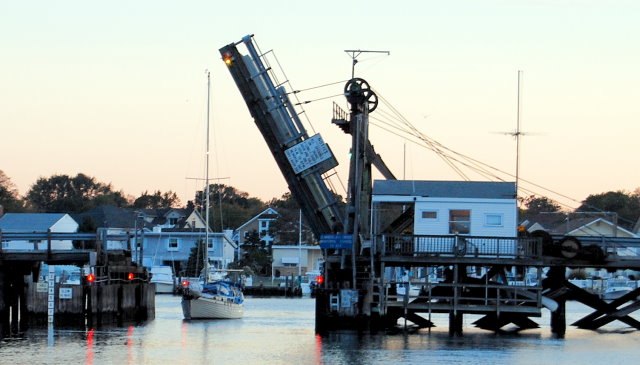We Recommend:
Bach Steel - Experts at historic truss bridge restoration.
BridgeHunter.com Phase 1 is released to the public! - Visit Now
Glimmer Glass Bridge
Brielle Road Bridge

Primary Photographer(s): Elaine Deutsch
Bridge Documented: July 1, 2016
Manasquan: Monmouth County, New Jersey: United States
Metal Deck Girder, Movable: Single Leaf Bascule (Belidor) and Approach Spans: Wood Stringer (Multi-Beam), Fixed
1994
34.0 Feet (10.4 Meters)
279.0 Feet (85 Meters)
20 Feet (6.1 Meters)
1 Main Span(s) and 16 Approach Span(s)
13000W9

View Information About HSR Ratings
Bridge Documentation
This bridge's future is at risk!
Bridge Status: At risk for demolition and replacement.View Archived National Bridge Inventory Report - Has Additional Details and Evaluation
View National Register of Historic Places Nomination Form For This Bridge
This is the last known surviving example of a Belidor type bascule bridge in the country. Despite never being common here, this bascule type was also built in Australia where they called it the "American" type of bascule bridge which is ironic since the type is nearly extinct in the United States today. A drone flyover of the bridge is on YouTube here. The Nomination Form linked above and the Historic Bridge Inventory information below provide a detailed discussion of the bridge, although note that the Historic Bridge Inventory was not aware of the bridge's 1938 construction date.
Above: Photo of the bridge in the open position. Photo Credit: Ben Eriksen, flickr.com/photos/bccelizabeth/4011518513/, CC BY-NC 2.0
Information and Findings From New Jersey's Historic Bridge InventorySummary The rolling counterweight single-leaf bascule bridge with a deck girder movable leaf is the only example of the late-19th century bridge type in the state and possibly the whole country. The undocumented bridge represents a little-used technology that was developed prior to 1895. It was used in New Jersey by railroads and over canals. Although the Glimmer Glass bridge has been modernized, it still operates in the original manner and is thus historically and technologically significant. Setting/Context The 2-lane bridge with single sidewalk spans Glimmer Glass, a navigable tidal inlet of the Manasquan River. The bridge is located in a salt marsh surrounded by what historically was a seasonal community of small cottages. Many of the cottages have been enlarged and/or converted to year round houses. Large, modern houses have also been added, often replacing the original cottages. The area does not have historic district potential. Physical Description The 17-span bridge is composed of 16 timber stringer spans supported on braced timber pile bents and a 31'-long cable lift bascule rolling counterweight movable span. The single-leaf movable span is a deck girder with an open steel grid deck installed in 1962. A cable attached to each side of the toe end of the movable leaf passes over a single-track sheave atop the braced timber tower columns with braced curved tracks on the side opposite the movable leaf. The opposite end of the cable is attached to a connecting hanger that joins the shafts of the rolling counterweights positioned in series on the track. The two topmost metal counterweights have a solid center guide while the last one has disk guides. The track has built up wood end stops. The tower columns are braced with wood struts on the sides and wire rope stays on the back. The toe lock is manual. The bridge is controlled from an operators house on the upstream side. An electric motor mounted atop the upstream tower column brace engages the drive shaft to turn the sheaves which cause the counterweights to start moving down the track. The motor reverses the action to close the bridge. The operators house, like many elements of the bridge, has been upgraded over the years, but its function and profile are original. Historical and Technological Significance The ca. 1898 cable lift bascule with rolling counterweights bridge is technologically and historically significant as the only example of its type in New Jersey (criterion C). It may also be the only example in the eastern half of the United States (Perkons). When the design was developed and by whom was not identified, but the 1896 Scientific American article describing the Erie Railroad's recently completed example on its main line over Berry's Creek near Rutherford, New Jersey (non-extant) states that " although the principle upon which the bridge is constructed is not entirely new, the Berry Creek bridge is the first application of this system of counter weighting for a structure of this magnitude." The principle is to use a curved track and rolling counterweights where the work expended in raising the leaf is equal to the energy released by the falling counterweight. The toe end of the movable span is linked by cables to cylindrical rolling counterweights. The connecting cable passes over a tower column with a curved track. Moving the counterweights along the curved track thus raises or lowers the bridge. It is known that in addition to erecting the rolling counterweight span at Berry Creek in 1896, the Erie Railroad used the technology to carry its Greenwood Lake branch over the Morris Canal, and that the Central Railroad of New Jersey built a similar bridge over the Morris Canal guard lock at Dover (Morris County). The canal bridges are recorded in the abundant photo documentation of the canal. Perhaps the best-known of the cable-lift rolling counterweight bridges was the 1897 Michigan Avenue bridge over the Buffalo River at Buffalo. A double-leaf span, it was designed and fabricated by the Wisconsin Bridge and Iron Company of Milwaukee. The steam-powered bridge was a more complicated design than the Glimmer Glass example, but the operating principle was the same. Another example was built in 1898 by the Canton Bridge Company (fabricator) and Dean and Westbrook (contractor) over Coney Island Creek between Brooklyn and Queens. The bridge type was also built in Australia and is known there as the "American" bridge. It was apparently introduced in that country prior to 1903, and the use of the design is noted as marking the shift from using English to American movable bridge technology. At least three examples survive, and one was built as late as 1922 (Fraser). No original records or plans for the Glimmer Glass span have been retained in the county engineer's files. It is dated ca. 1898 based on its design. The bridge has been rebuilt several times. The wood tower column and track were redone in 1957 and 1971, and the steel grid deck on the ca. 1950 deck girder movable span was installed in 1962. The significance of the structure is derived from the fact that it maintains integrity of original design. Boundary Description and Justification The bridge is evaluated as individually distinguished, and the significant boundary is limited to the bridge itself. The area surrounding the bridge does not possess the integrity needed to be evaluated as a potential historic district. Sources "Counterweighted Lift Bridge on the Erie Railroad," Scientific American, Vol. 75, (Nov. 28, 1896), pp. 389-390. Fraser, Donald J. "Movable Span Bridges in New South Wales Prior to 1915." Multi-disciplinary Engineering Transactions. 1985. Hool, George and Kinne, W.S. Movable and Long-Span Steel Bridges. New York: McGraw Hill Book Company, 1943."The Michigan Avenue Bascule Bridge Buffalo," The Engineering Record, Vol.66 (Aug. 21, 1897), pp. 246-247. Perkons, George (Mechanical Engineer with A.G. Lichtenstein and Associates). Personal interview with Mary E. McCahon, 1/19/1993. Waddell, J.A.L. Bridge Engineering. New York: John Wiley and Sons, 1925. Bridge Considered Historic By Survey: Yes |
![]()
Photo Galleries and Videos: Glimmer Glass Bridge
Bridge Photo-Documentation
Original / Full Size PhotosA collection of overview and detail photos. This gallery offers photos in the highest available resolution and file size in a touch-friendly popup viewer.
Alternatively, Browse Without Using Viewer
![]()
Bridge Photo-Documentation
Mobile Optimized PhotosA collection of overview and detail photos. This gallery features data-friendly, fast-loading photos in a touch-friendly popup viewer.
Alternatively, Browse Without Using Viewer
![]()
Maps and Links: Glimmer Glass Bridge
Coordinates (Latitude, Longitude):
Search For Additional Bridge Listings:
Bridgehunter.com: View listed bridges within 0.5 miles (0.8 kilometers) of this bridge.
Bridgehunter.com: View listed bridges within 10 miles (16 kilometers) of this bridge.
Additional Maps:
Google Streetview (If Available)
GeoHack (Additional Links and Coordinates)
Apple Maps (Via DuckDuckGo Search)
Apple Maps (Apple devices only)
Android: Open Location In Your Map or GPS App
Flickr Gallery (Find Nearby Photos)
Wikimedia Commons (Find Nearby Photos)
Directions Via Sygic For Android
Directions Via Sygic For iOS and Android Dolphin Browser
USGS National Map (United States Only)
Historical USGS Topo Maps (United States Only)
Historic Aerials (United States Only)
CalTopo Maps (United States Only)


